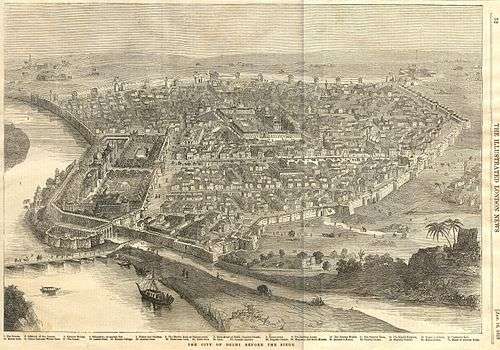Old Delhi
| Old Delhi पुरानी दिल्ली پُرانی دِلّی ਪੁਰਾਣੀ ਦਿੱਲੀ | |
|---|---|
| Walled City | |
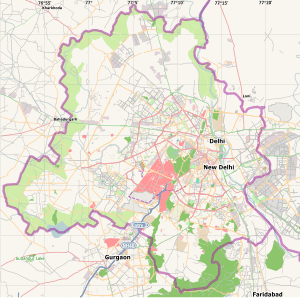 Old Delhi | |
| Coordinates: 28°39′39″N 77°13′48″E / 28.66083°N 77.23000°E | |
| Country | India |
| Union Territory | Delhi |
Old Delhi is a walled city of Delhi, India, was founded as Shahjahanabad (Persian: شاه جهان آباد) by Mughal Emperor Shahjahan in 1639.[1] It remained the capital of the Mughals until the end of the Mughal dynasty.[2][3] It was once filled with mansions of nobles and members of the royal court, along with elegant mosques and gardens. Today, despite having become extremely crowded and dilapidated, it still serves as the symbolic heart of metropolitan Delhi.
History
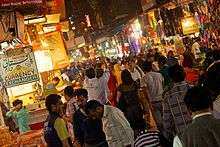

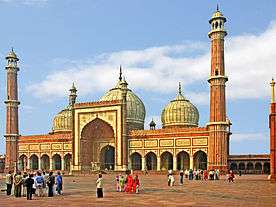
The site of Shahjahanabad is north of earlier settlements of Delhi. Its southern part overlaps some of the area that was settled by the Tughlaqs in the 14th century when it was the seat of Delhi Sultanate. The sultanates ruled from Delhi between 1206 and 1526, when the last was replaced by the Mughal dynasty. The five dynasties were the Mamluk dynasty (1206–90), the Khilji dynasty (1290–1320), the Tughlaq dynasty (1320–1414), the Sayyid dynasty (1414–51), and the Lodi dynasty (1451–1526).
Delhi remained an important place for the Mughals, who built palaces and forts . Most importantly, it was Shah Jahan, who had the walled city built from 1638 to 1649, containing the Lal Qila and the Chandni Chowk. Daryaganj had the original cantonment of Delhi, after 1803, where a native regiment of Delhi garrison was stationed, which was later shifted to Ridge area. East of Daryaganj was Raj ghat Gate of the walled city, opening at Raj Ghat on Yamuna River.[4] First wholesale market of Old Delhi opened as the hardware market in Chawri Bazaar in 1840, the next wholesale market was that of dry fruits, spices and herbs at Khari Baoli, opening in 1850. The Phool Mandi (Flower Market) of Daryaganj was established in 1869, and even today, despite serving a small geographical area, it is of great importance due to dense population.[5]
After the fall of the Mughal Empire post 1857 revolt, the British Raj shifted the capital of India to a less volatile city, Calcutta, where it remained until 1911. After the announcement of the change, the British developed Lutyens' Delhi (in modern New Delhi) just south-west of Shahjahanabad. At this point, the older city started being called Old Delhi, as New Delhi became the seat of national government. It was formally inaugurated as such in 1931. Until the 1930s, few people ventured outside the walled city; thus in the following years, as the walled city got more and more congested, other areas around it were developed.[6]
Walls and gates


It is approximately shaped like a quarter cìrcle, with the Red Fort as the focal point. The old city was surrounded by a wall enclosing about 1,500 acres (6.1 km2), with 14 gates:[7]
- Nigambodh Gate: northeast, leading to historic Nigambodh Ghat on the Yamuna River
- Kashmiri Gate: north
- Mori Gate: north
- Kabuli gate: west
- Lahori gate: west close to the Sadar Railway station, Railway Colony, including the tomb of Syed Abdul Rehman Jilani Dehlvi.[8][9]
- Ajmeri Gate: southeast, leading to Ghaziuddin Khan's Madrassa and Connaught Place, a focal point in New Delhi.
- Turkman Gate: southeast, close to some pre-Shahjahan remains which got enclosed within the walls, including the tomb of Hazrat Shah Turkman Bayabani.
- Delhi Gate: south leading to Feroz Shah Kotla and what was then older habitation of Delhi.
The surrounding walls, 12 feet (3.7 m) wide and 26 feet (7.9 m) tall, originally of mud, were replaced by red stone in 1657. In the Mughal period, the gates were kept locked at night. The walls have now largely disappeared,[10] but most of the gates are still present. The township of old Delhi is still identifiable in a satellite image because of the density of houses.
The famous Khooni Darwaza, south of Delhi Gate and just outside the walled city, was originally constructed by Sher Shah Suri.
Streets and neighbourhoods

The main street, now termed Chandni Chowk, runs from the Red Fort to Fatehpuri Masjid. Originally a canal ran through the middle of the street.
North of the street, there is the mansion of Begum Samru, now called Bhagirath Palace. South is the street is Dariba Kalan, a dense residential area, beyond which is Jama Masjid. Daryaganj is a section that used to border the river at Rajghat and Zeenat-ul-Masajid.
The Urdu language emerged from the Urdu Bazaar section of Old Delhi. The Din Dunia magazine and various other Urdu publications are the reason of this language staying alive.[11]
Its main arteries are
- Netaji Subhash Marg/Bahadur Shah Zafar Marg leading to India Gate (north and south)
- Chandni Chowk/Khari Bawli Road (east and west)
Old Delhi is approximately bounded by these modern roads:
- Gokhle Marg (south)
- Mahatma Gandhi Marg road (east)
- Shraddhananda Rd (west)
- Jawaharlal Nehru Marg (south)
Old Delhi in 1876

In 1876, Carr Stephen described the city as follows:[12]
Of the two streets described by François Bernier, the longer extended from the Lahore Gate of the city to the Lahore Gate of the citadel, and the other from the Delhi Gate of the city to the Lahore Gate of the fort. Both these streets were divided into several sections, each of which was known by a different name.
The section between the Lahore Gate of the fort and the entrance of the street called the Dariba, known as the Khuni Darwazah, was called the Urdu or the Military Bazaar; owing, very probably, to the circumstances of a portion of the local garrison having been once quartered about the place. Between the Khuni Darwazah and the present Kotwali, or the Head Police Station of the city, the street has the name of Phul ka Mandi or the flower market. The houses in front of the Kotwali were built at a short distance from the line of the rest of the houses in the street, so as to form a square.
Between the Kotwali and the gate known as the Taraiah, was the Jauhari or the Jewellers' Bazaar; between the Taraiah and the neighbourhood known as Asharfi ka Katra, was, par excellence, the Chandni Chauk. There was a tank in the centre of the Chauk the site of which is now occupied by the Municipal Clock Tower, and beyond this to the Fatehpuri Masjid was the Fatehpuri Bazaar. The houses round Chandni Chauk were of the same height, and were ornamented with arched doors and painted verandahs. To the north and south of the square there were two gate-ways, the former leading to the Sarai of Jehan Ara Begum, and the latter to one of the most thickly populated quarters of the city. Round the tank the ground was literally covered with vegetable, fruit, and sweetmeat stalls. In the course of time the whole of this long street came to be known as the Chandni Chauk.
This grand street was laid out by Jahanara Begam, daughter of Shah Jahan. From the Lahore Gate of the fort to the end of the Chandni Chauk the street was about 40 yards wide and 1,520 yards long. Through the centre of this street ran the canal of 'Ali Mardan, shaded on both sides by trees. On the eastern end of the Chandni Chauk stands the Lahore Gate of the Fort, and on the opposite end the handsome mosque of Fatehpuri Begam).
The clock tower no longer exists, although the locationn is still called Ghantaghar. The Sarai of Jehan Ara Begum has been replaced by the city hall. The kotwali is now adjacent to Gurdwara Sis Ganj Sahib.
Historical spots

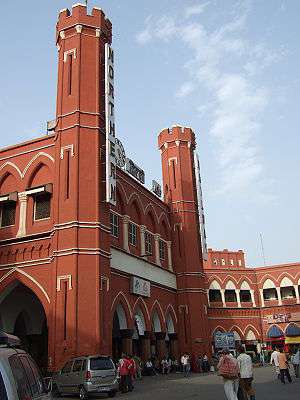
Many of the historical attractions are in the Chandni Chowk area and the Red Fort. In addition, Old Delhi also has:[13]
- Ghalib ki Haveli that is in Ballimaran is famous for Mirza Asadullah Khan Ghalib, the renowned Urdu and Persian poet.
- Gali Qasim Jan that is in Ballimaran is famous for Mirza Ghalib's haveli, and that of Hakim Ajmal Khan
- Razia Sultana's (Delhi's only female ruler before Indira Gandhi)— tomb near Kalan Masjid
- Jama Masjid, India's largest mosque
- Fatehpuri Masjid
- Khari Baoli, Asia's biggest spice market
- Zinat-ul Masjid, Daryaganj built in 1710 by one of Aurangzeb's daughters
- Rajghat, Mahatma Gandhi's cremation site memorial
- St. James Church (near Kashmiri Gate) built in 1836, Delhi's oldest church, built by Col. James Skinner.[14]
Some of the historical mansions include:[15][16]
- Begum Samru's Palace of 1806 (see )now called Bhagirath Palace.
- Naughara mansions in Kinari Bazaar, 18th century Jain mansions.
- Khazanchi haveli
- Haveli Sharif Manzil that is in Ballimaran is famous for its Aristocratic Hakims and their Unani practice, and that of Hakim Ajmal Khan
- Haveli of Mirza Ghalib, Gali Qasim Jan that is in Ballimaran
- Chunnamal haveli, Katra Neel
- Haveli of Zeenat Mahal, Lal Kuan Bazar
- Haksar Haveli, Bazar Sitaram, where Jawaharlal Nehru was married in 1916 to Kamla Nehru.
- Haveli Naharwali, Kucha Sadullah Khan, where Pervez Musharraf, former president of Pakistan was born
- Kucha Chelan (Kucha Chehle Ameeran), where the Persian descent inhabited
Old Delhi Cuisine

Old Delhi is well known for its cuisine. There area in and around Jama Masjid and Lal Kuan are predominantly Muslim. Hence the cuisine here is more meat dominant Mughlai cuisine. The area in and around Chandni Chowk is predominantly Jain and Baniya communities. Hence the food is strictly vegetarian and in a lot of cases made without onion and garlic. The famous Gali Paranthe Wali and Ghantewala halwai are also situated here.
Old Delhi is also famous for its street food. Chandni Chowk and Chawri Bazaar areas have many street joints that sell spicy chaat (tangy and spicy snacks).
See also
Further reading
- Delhi, the emperor's city: rediscovering Chandni Chowk and its environs, by Vijay Goel. Lustre Press, 2003. ISBN 81-7436-240-1.
References
- ↑ http://www.dawn.com/weekly/dmag/archive/080817/dmag9.htm PAST PRESENT: Shahjahanabad Before 1857 By Mubarak Ali
- ↑ History of Mughal Architecture By R. Nath, Abhinav Publications, 2006
- ↑ City of Djinns: A Year in Delhi By William Dalrymple, Olivia Fraser, HarperCollins, 1993
- ↑ Fanshawe, p. 67
- ↑ Ashok Kumar Jain (2009). Urban transport: planning and management. APH Publishing. pp. 166, 176. ISBN 81-313-0441-8.
- ↑ "A tale of two cities". Hindustan Times. September 1, 2011.
- ↑ http://www.milligazette.com/Archives/2004/01-15Jun04-Print-Edition/011506200496.htm Dilli's gates and windows By Mahtab Jahan
- ↑ Rehnuma-e-Mazaraat Delhi, Mohammad Asim-ul-Qadri Sanbhli, Mohammad Book Depot, 2007, Old Delhi India
- ↑ Sunbhli, Mohammad Asim Al-Qadri, 2007, Rehnuma-e-Mazaraat Delhi Sharif, Muhammadi Book Depot, 523 Waheed Kutb Market Matia Mahal Jamai Mosque, Delhi-6, India, p.p. 284
- ↑ Showers bring down ASI-protected wall in Old Delhi, ExpressIndia (web-site), The Indian Express, 2003-07-19
- ↑ Ghalib, 1797-1869: In 2vols .Vol.1, Life and Letters, By Mirza Asadullah Khan Ghalib, Ghalib, Asad-Allāh Ḫān Mīrzā Ġālib, Ralph Russell, Khurshidul Islam Published by Allen & Unwin, 1969
- ↑ Carr Stephen, Archaeology and Monumental Remains of Delhi (Author, 1876), pp. 246-47
- ↑ Old Delhi- 10 easy walks, by Malone Barton, 2006, South Asia Books
- ↑ The Last Mughal: The Fall of a Dynasty: Delhi, 1857, By William Dalrymple, Vintage, (March 11, 2008)
- ↑ Havelis of Old Delhi/Text by Pavan K. Varma and Sondeep Shankar. Reprint, First published in 1992. New Delhi,sexy, 1999
- ↑ Itihas ki dastan hain, Dilli ki havelian http://epaper.hindustandainik.com/blog/uploaded_images/historical_monument_resembles_delhi_haveli-765785.jpg
- H.C. Fanshawe (1998). Delhi, past and present. Asian Educational Services. ISBN 81-206-1318-X.
- Stephen P. Blake (2002). Shahjahanabad: The Sovereign City in Mughal India 1639-1739. Cambridge University Press. ISBN 0-521-52299-4.
External links
| Wikimedia Commons has media related to Old Delhi. |
- Street Pictures from Old Delhi
- "Purani Dilli continues to prosper". The Tribune. November 4, 2000.
- The Gastronomy of the Eye, a Photographer on the Streets of Old Delhi
| ||||||||||||||||||||||||||
